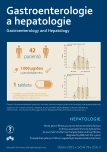Liver transplantation for hepatic PEComa mimicking hepatocellular carcinoma
Authors:
Selucká J. 1; Jiří Froněk 2; L. Voska 3; Dana Kautznerová 4; P. Taimr 1
Authors‘ workplace:
Klinika hepatogastroenterologie, IKEM, Praha 2 Klinika transplantační chirurgie, IKEM, Praha 3 Pracoviště klinické a transplantační patologie, IKEM, Praha 4 Pracoviště radiodiagnostiky a intervenční radiologie, IKEM, Praha
1
Published in:
Gastroent Hepatol 2022; 76(2): 121-126
Category:
Case Report
doi:
https://doi.org/10.48095/ccgh2022121
Overview
PEComas (perivascular epithelioid cell tumors) are rare mesenchymal tumours composed of epithelial perivascular cells. Most of these tumours have indolent behaviour, but occasionally they can have malignant potential. PEComas occur at any anatomical location and are 4 times more frequent in younger and middle-aged women. The diagnosis of PEComas is established incidentally in about 20% patients as a result of abdominal imaging. A typical microscopic feature of PEComas is the presence of perivascular epithelioid cells co-expressing both muscle and melanocytic markers. The only causal therapy is surgery. Our case report points at The diagnostic challenge of PEComas in, it describes a patient with malignant hepatic angiomyolipoma, who underwent liver transplantation for a bioptically proven diagnosis of hepatocellular carcinoma.
Keywords:
angiomyolipoma – liver transplantation – hepatocellular carcinoma – perivascular epithelioid cell neoplasm – mTOR inhibitors
Sources
1. Sobiborowicz A, Świtaj T, Teterycz P et al. Feasibility and long-term efficacy of PEComa treatment – 20 years of Experience. J Clin Med 2021; 10 (10): 2200. doi: 10.3390/jcm10102 200.
2. Klompenhouwer AJ, Verver D, Janki S et al. Management of hepatic angiomyolipoma: a systematic review. Liver Int 2017; 37 (9): 1272–1280. doi: 10.1111/liv.13381.
3. Kamimura K, Nomoto M, Aoyagi Y. Hepatic angiomyolipoma: diagnostic findings and management. Int J Hepatol 2012; 2012: 410781. doi: 10.1155/2012/410781.
4. Cudzilo CJ, Szczesniak RD, Brody AS et al. Lymphangioleiomyomatosis screening in women with tuberous sclerosis. Chest 2013; 144 (2): 578–585. doi: 10.1378/chest.12-2813.
5. Folpe AL, Mentzel T, Lehr HA et al. Perivascular epithelioid cell neoplasms of soft tissue and gynecologic origin: a clinicopathologic study of 26 cases and review of the literature. Am J Surg Pathol 2005; 29 (12): 1558–1575. doi: 10.1097/01.pas.0000173232.22117.37.
6. Schoolmeester JK, Howitt BE, Hirsch MS et al. Perivascular epithelioid cell neoplasm (PEComa) of the gynecologic tract: clinicopathologic and immunohistochemical characterization of 16 cases. Am J Surg Pathol 2014; 38 (2): 176–188. doi: 10.1097/PAS.0000000000000 133.
7. Parfitt JR, Bella AJ, Izawa JI et al. Malignant neoplasm of perivascular epithelioid cells of the liver. Arch Pathol Lab Med 2006; 130 (8): 1219–1222. doi: 10.5858/2006-130-1219-MNO PEC.
8. Zizzo M, Ugoletti L, Tumiati D et al. Primary pancreatic perivascular epithelioid cell tumor (PEComa): a surgical enigma. A systematic review of the literature. Pancreatology 2018; 18 (3): 238–245. doi: 10.1016/j.pan.2018.02.007.
9. Bennett JA, Braga AC, Pinto A et al. Uterine PEComas: a morphologic, immunohistochemical, and molecular analysis of 32 tumors. Am J Surg Pathol 2018; 42 (10): 1370–1383. doi: 10.1097/PAS.0000000000001119.
10. Hornick JL, Fletcher CD. Sclerosing PEComa: clinicopathologic analysis of a distinctive variant with a predilection for the retroperitoneum. Am J Surg Pathol 2008; 32 (4): 493–501. doi: 10.1097/PAS.0b013e318161dc34.
11. Armah HB, Parwani AV. Malignant perivascular epithelioid cell tumor (PEComa) of the uterus with late renal and pulmonary metastases: a case report with review of the literature. Diagn Pathol 2007; 2: 45. doi: 10.1186/1746-15 96-2-45.
12. Świtaj T, Sobiborowicz A, Teterycz P et al. Efficacy of Sirolimus treatment in PEComa-10 years of practice perspective. J Clin Med 2021; 10 (16): 3705. doi: 10.3390/jcm10163705.
13. Ishak KG. Mesenchymal tumors of the liver. In: Okuda K, Peters RL (eds). Hepatocellular carcinoma. NY: John Wiley and Sons 1976: 247–307.
14. Klompenhouwer AJ, Dwarkasing RS, Doukas M et al. Hepatic angiomyolipoma: an international multicenter analysis on diagnosis, management and outcome. HPB (Oxford) 2020; 22 (4): 622–629. doi: 10.1016/j.hpb.2019.09.004.
15. Yang X, Lei C, Qiu Y et al. Selecting a suitable surgical treatment for hepatic angiomyolipoma: a retrospective analysis of 92 cases. ANZ J Surg 2018; 88 (9): E664–E669. doi: 10.1111/ans. 14323.
16. Mao JX, Yuan H, Sun KY et al. Pooled analysis of hepatic inflammatory angiomyolipoma. Clin Res Hepatol Gastroenterol 2020; 44 (6): e145–e151. doi: 10.1016/j.clinre.2020.04. 005.
17. Liu J, Zhang CW, Hong DF et al. Primary hepatic epithelioid angiomyolipoma: a malignant potential tumor which should be recognized. World J Gastroenterol 2016; 22 (20): 4908–4917. doi: 10.3748/wjg.v22.i20.4908.
18. Dabora SL, Franz DN, Ashwal S et al. Multicenter phase 2 trial of sirolimus for tuberous sclerosis: kidney angiomyolipomas and other tumors regress and VEGF- D levels decrease. PLoS One 2011; 6 (9): e23379. doi: 10.1371/journal.pone.0023379.
19. Lenci I, Angelico M, Tisone G. Massive hepatic angiomyolipoma in a young woman with tuberous sclerosis complex: significant clinical improvement during tamoxifen treatment. J Hepatol 2008; 48 (6): 1026–1029. doi: 10.1016/j.jhep.2008.01.036.
Labels
Paediatric gastroenterology Gastroenterology and hepatology SurgeryArticle was published in
Gastroenterology and Hepatology

2022 Issue 2
Most read in this issue
- Risk of liver fibrosis in patients undergoing surgical treatment of hip trauma
- Ketoanalogue of essential amino acids in patients with inflammatory bowel disease (IBD) and chronic kidney disease (CKD) in preparation for kidney transplantation
- Liver transplantation for hepatic PEComa mimicking hepatocellular carcinoma
- Oral vitamin B12 therapy supplementation in patients with ileo-colonic resection for Crohn’s disease
